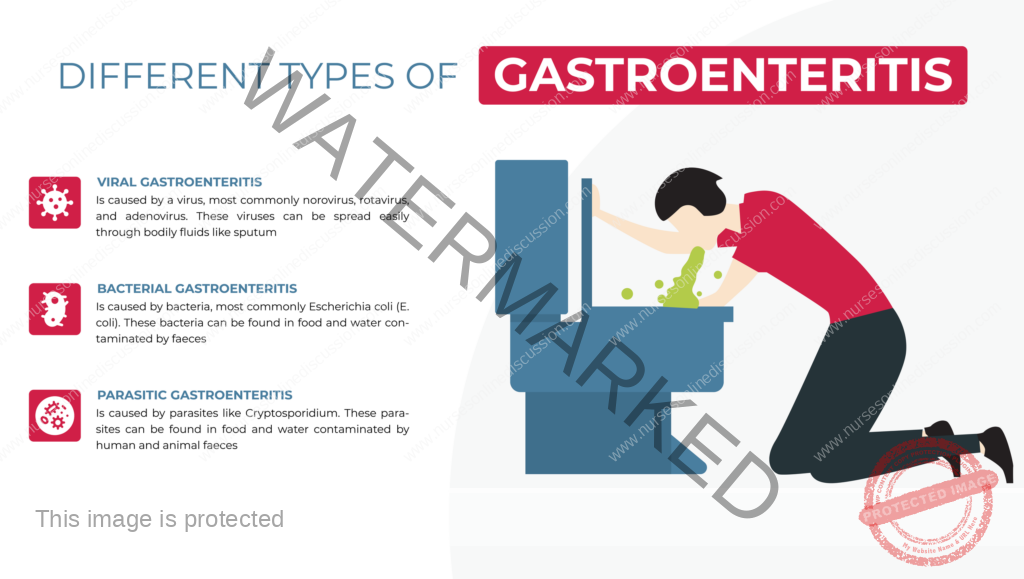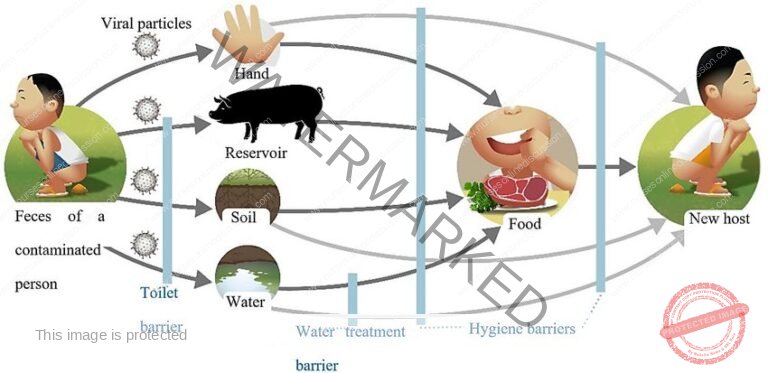Diploma in Midwifery
Gastroenteritis (GE)
Table of Contents
Gastroenteritis (GE), often referred to as “stomach flu” (though it’s not caused by the influenza virus), is a medical condition involving inflammation of the gastrointestinal (GI) tract. This inflammation specifically affects both the stomach (“gastro-“) and the small intestine (“entero-“). The primary symptoms that arise from this inflammation include diarrhea, vomiting, and abdominal pain and cramping.
In cases of infectious gastroenteritis, the severity of the illness is closely linked to the individual’s immune system. A stronger immune response can often better combat the infection, leading to a milder course.
A significant consequence of the vomiting and diarrhea associated with gastroenteritis is the potential loss of electrolytes. These essential minerals, mainly sodium and potassium, are crucial for various bodily functions, and their depletion can lead to further complications if not addressed.

Causes of Gastroenteritis (GE)
Viruses
Rotavirus, norovirus, adenovirus, and astrovirus are known to cause viral gastroenteritis.
Rotavirus is the most common cause of gastroenteritis in children.
Norovirus is the leading cause of gastroenteritis among adults, causing greater than 90% of outbreaks.
Bacteria
In the developed world Campylobacter jejuni is the primary cause of bacterial GE.
Escherichia coli
Salmonella, Shigella, and Campylobacter species.
Salmonella is contracted by ingesting the bacteria in contaminated food or water and by handling poultry.
Campylobacter occurs by the consumption of raw or undercooked poultry meat and other foods. It is also associated with unpasteurized milk or contaminated water.
Clostridium difficile is an important cause of diarrhea that occurs more often in the elderly. It is a common cause of diarrhea in those who are hospitalized and is frequently associated with antibiotic use.
Staphylococcus aureus infectious diarrhea may also occur in those who have used antibiotics.
Parasites
A number of protozoans can cause gastroenteritis – most commonly:
Giardia lamblia
Entamoeba histolytica
Cryptosporidium
Non-infectious causes
Medications like NSAIDs
Certain foods such as lactose (in those who are intolerant).
Crohn’s disease.
Transmission of Gastroenteritis
The spread of germs causing gastroenteritis occurs through contact with the feces or vomit of infected individuals. Transmission can happen in the following ways:
Consuming untreated or unboiled water from rivers, streams, lakes, ponds, or unprotected springs.
Eating cold food that has been exposed to dust, flies, or cockroaches.
Neglecting to wash hands with soap and water after using a latrine.
Eating unwashed fruits and vegetables.
Serving food and drinks in dirty containers.
Storing drinking water in unclean containers.
Improper disposal of feces.
Presence of open rubbish in areas that attract flies and cockroaches.

Signs and Symptoms:
Primary symptom is diarrhea, often with vomiting.
Blood or mucus may be present in stools.
Crampy abdominal pain, which may lessen after passing stool.
Possible low-grade fever, headache, and body aches.
Symptoms of dehydration:
- Muscular cramps
- Sunken eyes
- Decreased urine output
- Dry mouth and tongue
- Weakness
- Irritability
Severe dehydration symptoms in adults:
- Fatigue
- Dizziness or lightheadedness
- Headache
- Weakness
- Confusion
- Rapid heart rate
- Coma
- Significantly reduced urine production.
Diagnosis:
Gastroenteritis is diagnosed clinically based on signs and symptoms.
Stool cultures should be performed, especially with blood in the stool.
Management:
- Gastroenteritis is usually acute and self-limiting, not requiring medication.
- Oral rehydration therapy (ORT) is the preferred treatment for mild to moderate dehydration.
- Intravenous fluids may be needed for decreased consciousness or severe dehydration.
- Plain water can be used if ORT is unavailable or unpalatable.
- A nasogastric tube can be used for fluid administration in young children.
- Institute a fluid balance chart.
- Metoclopramide may help some children.
- Butylscopolamine is useful for abdominal pain.
- Fermented milk products (like yogurt) can be beneficial.
- Zinc supplementation is effective for treating and preventing diarrhea in children.
- Antibiotics are usually not used.
- Antibiotics may be considered for severe symptoms or suspected/isolated bacterial cause.
- If antibiotics are used, a macrolide (like azithromycin) is preferred.
- Metronidazole or Tinidazole is used for protozoa.
- Isolate the patient to prevent cross-infection.
- Proper disinfection and disposal of stool and vomit
Prevention and Control:
Always wash hands with soap and water before preparing, serving, or eating food.
Always wash hands with soap and water after using a latrine.
Boil all drinking water or treat it with chlorine and store it in a clean container.
Consume food while it is still hot.
Ensure raw foods like fruits and vegetables are properly washed and peeled when possible before eating.
Cover all foods to prevent contamination by dust, house flies, and cockroaches.
Report any deaths due to diarrhea to health authorities immediately.
Disinfect stool or vomit and contaminated materials using germ-killing solutions like bleach.
Improve water and sanitation to reduce infection transmission.
Conduct investigations of diarrheal outbreaks.
Treat other infections such as typhoid and dysentery.
Address and treat malnutrition.
Consider rotavirus vaccination for protection against a common cause of gastroenteritis